Apple's MacBook Pro: Using it as a Mac and a PC
by Anand Lal Shimpi on April 13, 2006 12:00 AM EST- Posted in
- Mac
Parallels' Workstation 2.1 Beta w/ Intel VT Support
The biggest downside to Boot Camp is that you have to reboot your system in order to use it. That means you've got to save all of your work, close down all of your apps, stop what you've been working on and head on into Windows. While Boot Camp is extremely convenient for those users who are debating the Mac switch but are worried about going cold turkey, in the long run it's only convenient for those who are going to occasionally be switching between the two OSes.
Even before Boot Camp, Virtual PC and other PC emulators have existed for Mac users that needed to run Windows. The emulators would generally work in a window inside OS X and you could do things like copy text between the two OSes, but most importantly you could run and use Windows without ever logging out of OS X. The downside of course is that performance under emulators like Virtual PC is often terrible, which makes them frustrating to use, especially on slower laptop hardware. Luckily, modern day Intel CPUs - including the Core Duo used in Intel based Macs - support Intel's Virtualization Technology (VT for short) which is designed to make the job of a virtual machine a bit easier and thus increase performance.
One developer of Virtualization software, Parallels, Inc., has released a beta of Virtualization software for OS X with support for Intel's VT. Parallels' solution offers the first hardware accelerated virtualization software for OS X, meaning in theory you should be able to run Windows XP alongside OS X and get almost the same performance as you would if you were using Boot Camp.
Currently Parallels' Workstation 2.1 for Mac OS X is only available as a free trial of Beta 2. It will eventually be sold for $49.99 and you can pre-order it now for $39.99. As a Virtual Machine Manager (VMM), Parallels' Workstation installs from within OS X and doesn't require any reboots or anything like that.
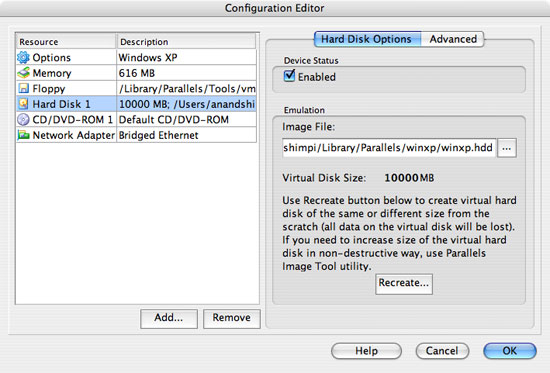
You simply install the application and then start configuring your virtual machines. Although I only played with a Windows XP VM, you can run any version of Windows from 3.1 all the way up to 2003 Server, as well as any Linux distribution, FreeBSD, Solaris, OS/2, eComStation or MS-DOS.
Parallels' Workstation automatically detects and enables Intel VT support if it's present, so there's nothing MacBook Pro users need to do differently to get the most performance out of the hardware. Creating a Windows XP VM requires just a few decision: how big should the hard drive be, how much memory should be allocated to the VM, and what network controller will the VM use? Make those decisions and configure the VM appropriately, and everything is ready for use.
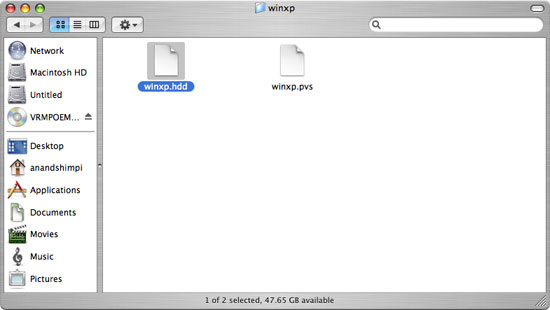
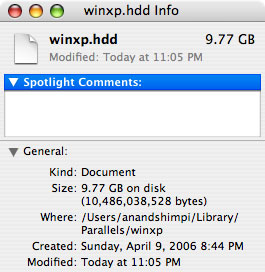
Like my Boot Camp partition, I chose a 10GB drive for the XP VM. The VM's hard drive is treated as a single file in OS X so you don't need to worry about creating any partitions. The VM manager recommended I set aside 616MB of memory for Windows XP and for testing purposes I did just that, although if you really plan on using Windows alongside OS X for a lot of work then I would suggest upgrading to 2GB in your MacBook Pro.
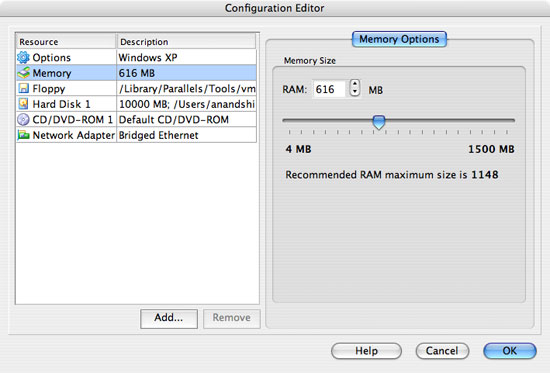
I allowed the VM to use my wireless connection and it appeared as a normal wired Ethernet connection in Windows XP. All network requests that are sent to that virtual network adapter are handed off to the VM which in turn requests them through the wireless adapter in OS X. However the VM manager only lets you bridge a single network connection, so on the MacBook Pro you can only make either your wired or wireless connection available to your VM. Luckily, it's not difficult at all to change this option so it's not too annoying.
Unfortunately I couldn't get the VM to let Windows XP access my CD/DVD drive, so I was forced to make an image of my Windows XP CD to install it. Using OS X's Disk Utility I created a CD/DVD Master image of my Windows XP SP2 disc and renamed it from a .cdr to .iso so the VM would recognize it. I selected it as my CD image and fired up the VM. (This has since been fixed in Beta 3 of Parallels' Workstation 2.1 for OS X.)
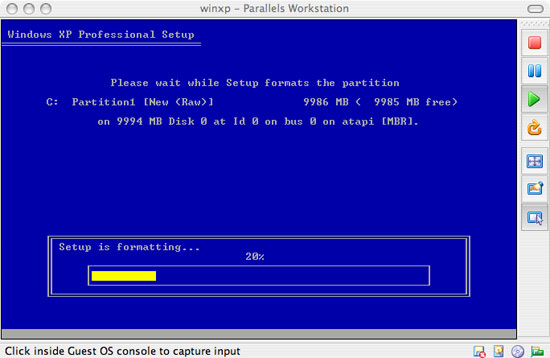
Since the Windows XP image was actually on my hard drive the setup process went extremely fast. With Windows installed, it was time to use it.










52 Comments
View All Comments
boinkle - Thursday, April 13, 2006 - link
Great review, apart from making me think "that's still quite pretty!", at the end of the day it's just a PC in an Apple enclosure. It's shiny, fast, but has all the problems of an Apple 1st gen product, with few of the benefits of Core duo showing up...How I wish someone had given Freescale some incentive to develop the G4 further (to a reasonablt timescale). It's amazing that it's still even *reasonably* competitive. Imagine dual-core, 65nm G4 derivative production? Don't TI have a 65nm fab up and running now? That's where your 5 hours would come from, Anand... pie in the sky, I know.
*sigh*
littlebitstrouds - Thursday, April 13, 2006 - link
How about some gaming benchmarks. If you run windows and game are you getting good performance numbers? If I could have a Mac for everyday use and boot up windows when I want to game I might jump on this.Visual - Thursday, April 13, 2006 - link
you have some borked page 18 after the "final thoughts" page showing up in the dropdown.in printarticle.aspx it shows up as a duplicate of page 17 for some reason
as to the article itself - good job :)
my guess as to why the vm is faster than the real thing is because the hdd emulation works somewhat like a ramdrive - its a file on the apple hdd but it probably gets cached up by osx or by the vmsoftware itself.
plinden - Thursday, April 13, 2006 - link
That could be - I have maxed out at 2GB RAM in my iMac, and I get wired RAM is close to the max and a hefty number of Page Outs (up to 210,000 last time I looked. before it setayed below 5000 even after being on for a week) while running Parallels VM.
ibisbowti - Thursday, April 13, 2006 - link
I been using the 1.83 Core Duo for about a week now. I think it is one of the latest builds according to the serial number. No problems at all, other than it does get pretty warm. Heat issue seems better after latest firmware update. I think the aluminum is designed to be a big heat sink! I thought the Front Row software would be a little gimmicky, but it is pretty cool, especially when sitting the unit on a coffee table and watching the HD movie trailers, IPhoto pics, etc with others. It's an awesome machine so far.artifex - Thursday, April 13, 2006 - link
Since you say you ran the same tests as in your earlier review, I'd like to see graphs comparing the results of the Intel iMac vs. the MBP. and add in ones for the Intel Mini, if you can. I suspect we'll see iMac > MBP > Mini, but it would be nice to be sure.Also, if you could slap Parallels on the Mini and tell us how much of a hit the virtualization takes because the hardware virtualization is disabled for that line, that would be really interesting.
Thanks.
AppaYipYip - Thursday, April 13, 2006 - link
"Apple quality control at it's best"That comment bothers me. Overall, there are no other manufacturers that come even close to Apples quality, design, and workmanship. Yet, you find one key that sits slightly off and suddenly feel the need to make such a blanket statement. If it bothers you so much, take it back and Apple will repair it for you, in record time.
Calin - Thursday, April 13, 2006 - link
The IBM thinkpads (before the Lenovo deal) were regarded as the best business laptops (or at least PC laptops) as quality and workmanship. Too bad they were designed with cramped keyboards (at least the models I saw) and no trackpad.Ryan Norton - Thursday, April 13, 2006 - link
I'm a PC guy but I like Macs a lot and will probably buy a Macbook Pro, either now or when Merom ones come out. I figure Anand probably is too. Yet I work with Mac zealots who give me endless shit about the unequivocal superiority of Apple everything over PC (except for games, which they concede). So when someone like me finds a glaring flaw that seems like something that should have been spotted before it got to the end user, it's easy to take a cheap shot at Jobs =^)Sunrise089 - Thursday, April 13, 2006 - link
If I had my dream review of this product, here's how I would have you test gaming performance:Test performance in Windows mode. Then compare it to other Core Duo notebooks. Then see if there is any game written natively for OS-X under Core Duo, and run the OS-X version and the Windows version to see the difference in OS on performance on the same machine.
Other than no gaming info, terrific review.